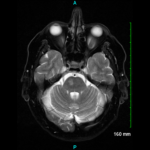The MRI finding has been called the checkmark sign because that’s the shape formed by the T2-weighted hyperintensity within the orbital apex due to the typical branching of the third cranial nerve within the superior orbital fissure.3 The apparent specificity of this finding for third cranial nerve involvement in GCA may provide another non-invasive way to evaluate for the disease and, in particular, identify patients at risk for ocular ischemia.
Research
Dr. Mackie intimated that many rheumatologists would recall the 2017 publication of the Giant-Cell Arteritis Actemra (GiACTA) trial. In this phase 2, randomized, placebo-controlled study, a significantly larger number of patients with GCA receiving tocilizumab, either every week or every other week, achieved steroid-free remission at 52 weeks than those receiving placebo.4
In a further evaluation of this study, Stone et al. investigated glucocorticoid doses and serologic findings in patients with GCA flares. Although 24% of patients treated with tocilizumab experienced flare, 58% of patients treated with placebo experienced flare. Many of the flares in these groups occurred while patients were still receiving prednisone at doses greater than 10 mg per day.
Another interesting finding was the degree of discordance between the inflammatory marker level and the status of disease activity. Not only did several flares—33 in the tocilizumab-treated group and 20 in the placebo group—occur with patients demonstrating normal C-reactive protein (CRP) levels, but also more than half of placebo-treated patients with elevated CRP levels did not experience flare.5
This study indicates clinicians must carefully monitor for flares of GCA in patients treated with and without tocilizumab. Relying on inflammatory markers alone may not be sufficient to gauge disease activity.
Disease Activity
Dr. Mackie asked: How should rheumatologists best monitor disease activity in patients being treated for GCA? Rheumatologists must take into account several parameters, including signs and symptoms of active disease, which require expertise to assess; blood testing, which is useful, albeit imperfect; and possibly imaging results via ultrasound, magnetic resonance angiogram and FDG-PET/CT, though abnormalities can persist on imaging without disease being clinically active.
Disease activity is important with respect to assessing its impact on the patient’s overall health and life. Early potential complications in GCA include stroke and vision loss. Other manifestations include infections, diabetes, fractures, cardiovascular events and aortic dilatation. There is certainly a life impact on patients in the form of burden of symptoms from GCA and its treatment. Additionally, the total cost to individuals and society in terms of deaths from the disease and healthcare expenses is sizable.

